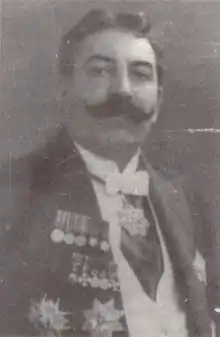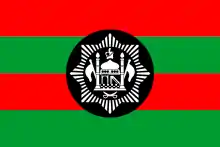Ali Ahmad Khan
Ali Ahmad Khan Luynab (1883–1929) was an Afghan politician from the Barakzai tribe, and was for a few weeks a possibly self-proclaimed[note 1] emir in eastern Afghanistan in January and February 1929.
| Ali Ahmad Khan | |||||
|---|---|---|---|---|---|
 | |||||
| Emir | |||||
| Reign | 17 January 1929 – 9 February 1929 | ||||
| Predecessor | Inayatullah Khan | ||||
| Successor | Habibullah Kalakani | ||||
| Born | 1883 Mashhad, Sublime State of Persia | ||||
| Died | 11 July 1929 (aged 45–46) Kabul, Kingdom of Afghanistan | ||||
| |||||
| Father | Loinab Khushdil Khan[1] | ||||
| Religion | Islam | ||||

Born in 1883 in Mashhad, Iran, he played a leading role in negotiating the controversial Anglo-Afghan Treaty of 1919 which ended the Third Anglo-Afghan War, and later rallied the Khogyani and Shinwari to quell the Khost rebellion. He also served as high commissioner of the Eastern and Southern provinces.[4]
During the Afghan civil war of 1928–29, Ali was ordered to quell a Shinwari revolt, which he duly ended in December 1928.[5] Later, after Inayatullah Khan surrendered control of Kabul to Habibullāh Kalakāni on 17 January 1929, he created a rival government centered on Jalalabad.[3] However, Ali's reign would prove short-lived: Malik Qays of the Khugyani tribe, who had initially allied himself with Ali, defected to Kalakani, captured Ali and brought Ali to Kalakani in exchange for 17,000 rupees and the rank of lieutenant general,[3] ending Ali's reign on 9 February.[6]
Ali later managed to escape from imprisonment and sought refuge in Kandahar with his sons Ghulam and Nur. On 3 June or 31 May 1929[note 2], Kandahar fell to forces loyal to Habibullāh Kalakāni, and the former emir was found in the home of a Hazarah. His son Nur was killed on the spot, while Ali himself was arrested and sent to Kabul along with Abd al-Shakur Khan (The Chief of Justice), Sad al-Din Khan (Abd al-Shakur Khan's son), Abd al-Wasi, and a Mufti. When Ali Ahmad Khan arrived in Kabul, he was paraded through the bazaars stripped naked,[4] after which he remained imprisoned in Kabul for over a month. On 11 July 1929, Ali's life ended with his execution.[8]
Notes
- According to the account of Mohammad Ali in Progressive Afghanistan (1933), Ali Ahmad Khan "proclaimed himself King at Jalalabad".[2] However, according to Fayz Muhammad, Ali was proclaimed emir by "the people of the Jalalabad region".[3]
- According to Encyclopædia Iranica, Kandahar fell on 31 May,[7] while according to Faiz Mohammad, it fell on 3 June.[4]
References
- Adamec, Ludwig W. (2012). Historical Dictionary of Afghanistan. Scarecrow Press. p. 42. ISBN 9780810878150.
- Ali, Mohammed (1933). Progressive Afghanistan. Punjab Educational Electric Press. p. 52.
- Muḥammad, Fayz̤; McChesney, R. D. (1999). Kabul under siege: Fayz Muhammad's account of the 1929 Uprising. Markus Wiener Publishers. pp. 51, 52, 53. ISBN 9781558761544.
- Muḥammad, Fayz̤; McChesney, R. D. (1999). Kabul under siege: Fayz Muhammad's account of the 1929 Uprising. Markus Wiener Publishers. pp. 82, 83. ISBN 9781558761544.
- Muḥammad, Fayz̤; Hazārah, Fayz̤ Muḥammad Kātib (1999). Kabul Under Siege: Fayz Muhammad's Account of the 1929 Uprising. Markus Wiener Publishers. pp. 35, 36, 37. ISBN 9781558761551.
- "Afghanistan". www.worldstatesmen.org. Retrieved 2019-01-20.
- "BAČČA-YE SAQQĀ – Encyclopaedia Iranica". www.iranicaonline.org. Retrieved 2019-04-23.
- Muḥammad, Fayz̤; McChesney, R. D. (1999). Kabul under siege: Fayz Muhammad's account of the 1929 Uprising. Markus Wiener Publishers. pp. 84, 85. ISBN 9781558761544.
Ali Ahmad Khan Born: 1883 Died: 1929 | ||
| Regnal titles | ||
|---|---|---|
| Preceded by Inayatullah Khan |
King of Afghanistan 1929 |
Succeeded by Habibullah Kalakani |